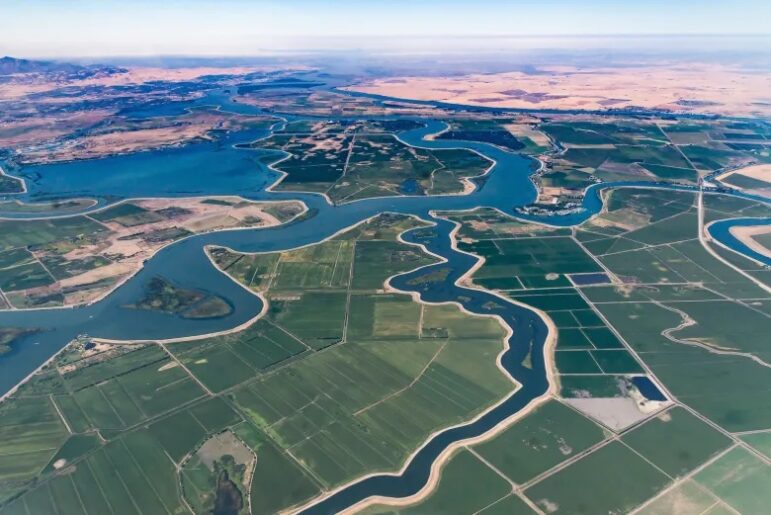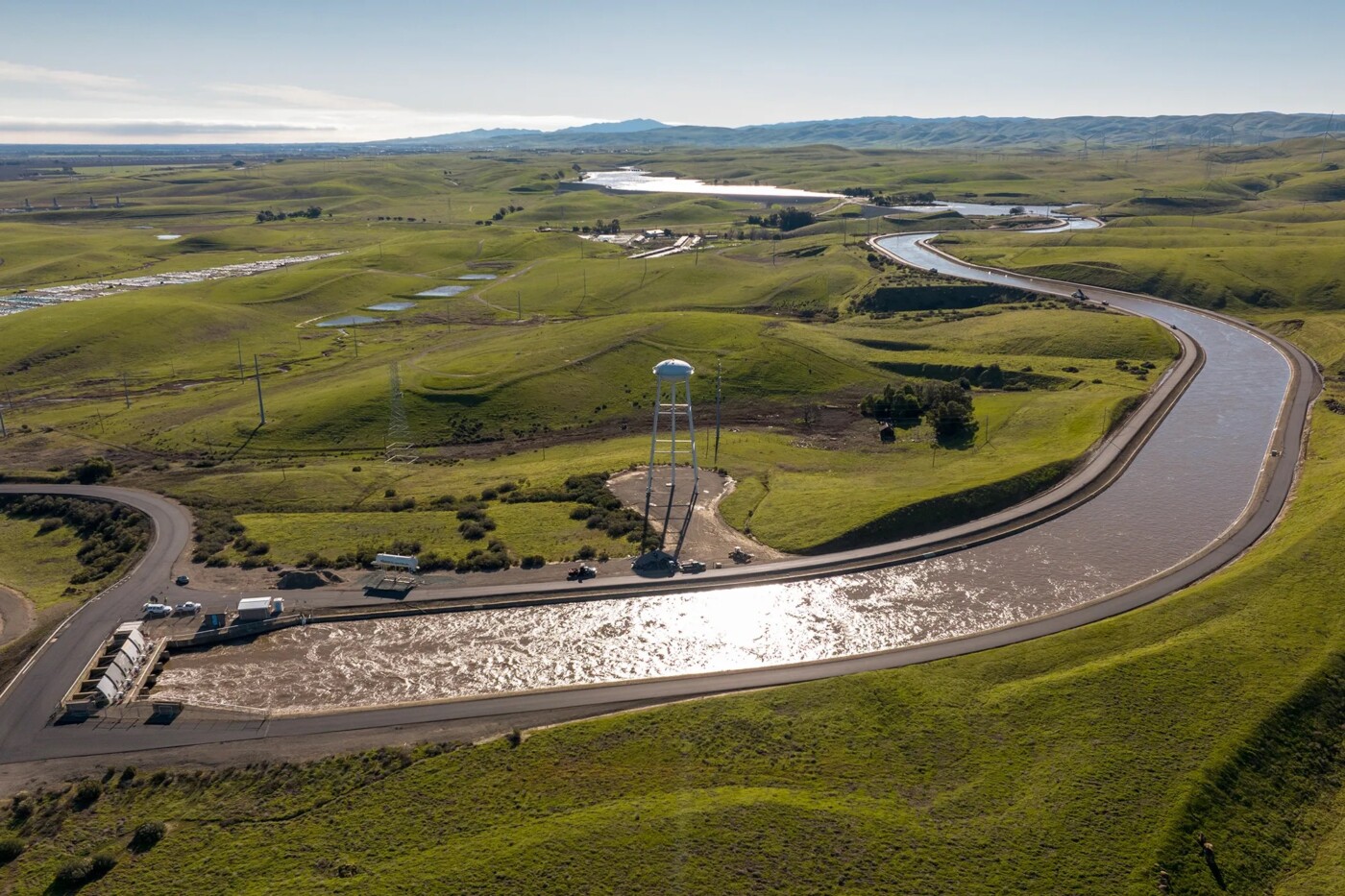Lea este artículo en español.
Gov. Gavin Newsom wants to make it easier for California to build big things. Today, he unveiled a plan to make it happen.
At an 1,100 acre solar farm near Patterson in Stanislaus County, Newsom announced a package of legislative proposals and signed an executive order aimed at speeding big infrastructure projects. He aims to limit the time opponents can jam projects up in court with challenges under the California Environmental Quality Act, the law known as CEQA (and pronounced see-kwa).
Buoyed by an influx of federal dollars and motivated by the need to dramatically reduce the state’s greenhouse gas emissions, Newsom’s “CEQA-reform” proposal is likely to be cheered by industry groups, construction unions and even some climate activists.
He said the plan was about more than the urgency of climate change, but about rebuilding the public’s faith in the state’s ability to commit to and accomplish big things.
“As someone who’s all in on high-speed rail…all I can think about is, ‘what if?’ ‘What if we had these principles before we laid out that project?’” he said, referring to the $128 billion, much-delayed rail project. “I may not have had to drive down here today. I may have been on that rail.”
California isn’t short on what the governor might call “big hairy audacious goals.” The state has a plan to harvest all of the state’s electricity from carbon-free sources by 2045. The Newsom administration adopted a plan to phase out the sale of gas-guzzling cars, shifting the state’s appetite for driving onto the electricity grid. Proposed projects on water — to store it, to strip it of saltwater, to keep it at bay as sea levels rise and rivers top their banks — abound.
To meet those goals, California needs to build, potentially at a scale that would dwarf even the boom times of the 1960s. At a breakfast gathering of big business representatives in Sacramento on Thursday, the governor stressed that the state is ready to spend $180 billion over the next 10 years, much of that money coming from the federal government.
“The question is, are we going to screw it up by being consumed by paralysis and process?” Newsom asked.
Several leading organizations quickly issued statements expressing skepticism about Newsom’s proposal to modify the state’s landmark environmental law. Their leaders wanted to see more details than his office disclosed this week.
“We need to meet the state’s climate goals with smart, carefully considered projects, not knee-jerk construction that bypasses the necessary protections that keep us safe,” said Aruna Prabhala, a senior attorney at the Center for Biological Diversity.
Have questions about Newsom’s big proposal? Here’s what we know.
Q: What is the governor actually proposing?
A: Details are still sparse, but his executive order, a summary of 11 bills released by his office, a separate report put out by administration infrastructure adviser Antonio Villaraigosa and Newsom’s remarks speak to the following goals:
- Streamline environmental planning by coordinating among different local, state and federal agencies;
- Limit the amount of time courts have to weigh environmental challenges to nine months;
- Provide more funding to agencies to speed up reviews;
- Cut back on the number of documents that each review requires;
- Carve out more exemptions in the law to allow favored projects to skip certain environmental reviews.
Some of these changes would broaden provisions already included in state law. The nine-month limit on environmental litigation, for example, already applies to renewable energy projects, certain housing and even major sports stadiums.
“I love sports,” Newsom said. “But I also love roads. I love transit. I love bridges…why the hell can’t we translate that to all these other projects?”
Q: Is Newsom’s ‘CEQA reform’ plan a big deal?
A: To hear Newsom say it, this is a very big deal.
“If we get nothing else done in the next three years, this may be one of the most consequential things that we can actually deliver,” he said on Thursday.
For decades, California’s deliberate — or as critics argue, glacially slow and unpredictable — permitting process has been a hallmark of its environmental policy. At the heart of that process is the California Environmental Quality Act.
California lawmakers passed the law in 1970, riding a new public consciousness of environmental conservation and protection. It was a bipartisan sentiment. The governor who signed the law was Ronald Reagan while President Richard Nixon signed its federal counterpart that same year.
At the time, the chief environmental concerns were local and growth-related: The incursion of development into green spaces and sensitive ecosystems; the widespread use of pesticides; the pollution of rivers and the befouling of oceans; littering.
Business interests have decried “CEQA abuse” for decades. Now that climate change is the chief environmental concern of the day, some liberals are on board with “permitting reform” bandwagon, too.
They argue the state needs to build at an unprecedented scale to decarbonize its electricity grid and transportation networks.
Jennifer Hernandez, a land use and environmental attorney in San Francisco, said she was cautiously optimistic that the changes the governor spoke about would speed litigation.
In particular, the governor’s comments regarding addressing what constitutes an administrative record under the environmental law, could go far, she said.
When a civil lawsuit is filed under the environmental law, the first thing that occurs is preparation that can take months to more than a year to gather. That’s because the administrative record is broadly defined, she said. It can include emails, text messages by officials and other pieces of information that may not strictly pertain to the environmental impact of a project, she added.
“The administrative record was defined about 20 years ago, to include internal agency communications, even emails about whether you want pizza for the meeting,” Hernandez said.

Q: What types of projects will be affected?
A: In the executive order, Newsom called out a few spending areas specifically: “transportation, energy, hydrogen, environmental remediation, broadband, water, the CHIPS and Science Act (for semiconductor development), and zero-emission vehicles.”
Newsom named two major water proposals as examples of the kinds of projects that could benefit from the package: the Sites Reservoir in the Sacramento Valley and a tunnel that would funnel water under the Sacramento-San Joaquin Delta.
Osha Meserve, an attorney in Sacramento who has represented opponents of the tunnel, said rigorous environmental review is justified when it comes to projects like the tunnel, which has been the focus of disagreement and legal challenges for decades.
“If you’re going to go across four counties and build the largest new infrastructure project in the whole state, then yes, you’re going to need some detailed environmental reviews,” Meserve said.
Jerry Brown, the executive director of the Sites Project Authority (and not the former governor of the same name), said the governor’s proposed CEQA reform could advance the process of acquiring a water right for the proposed Sacramento Valley reservoir by about six months.
“That means we get into construction sooner, means we finish construction sooner,” he said “We’re talking about a project here where a year delay costs about $100 million.”
Q: What about housing?
A: Newsom didn’t mention housing prominently at his press conference.
His administration is urging local governments to permit more than 2.5 million new units over the next eight years. Among pro-housing advocates, the environmental law is often cited as an unwelcome impediment — both because opponents can sue and delay projects and because the mere prospect of a lengthy legal battle can result in fewer and smaller housing projects being proposed.
Asked about housing by a reporter, Newsom noted that some of the broad changes to permitting and record-keeping policy will speed up the construction of new homes, along with everything else.
Q: Will the plan harm the environment?
A: Not if you ask the governor, it goes without saying.
“I care deeply about what the environmental community believes and thinks, but at the same time I care deeply about the progress we’re promoting here today,” he said today.
Newsom had some backing from at least one major green group: Environment California, a nonprofit that often stakes out a centrist position on climate-related policy.
“We need to work harder, better, faster, stronger to build five times as much clean energy every year,” the group’s director Laura Deehan said at today’s press conference.
But it’s not clear whether the state’s broader environmental community will be as enthused.
In a statement, Sierra Club California director Brandon Dawson said that the group is still reviewing the idea, but expressed serious reservations. “We acknowledge the governor’s desire to promote clean infrastructure, but this proposal needs a lot of work,” he said.
Barbara Barrigan-Parrilla, the executive director of the group Restore the Delta, lashed out at the governor following the release of the order.
“We have never been more disappointed in a California governor than we are with Gov. Newsom,” she said in a statement.
Q: What are the odds this goes anywhere?
A: It’s too early to tell.
The governor’s office released bill language late Friday afternoon and lawmakers in general have yet to read the details.
Senate leader Toni Atkins in a written statement said climate change demands the state “move faster to build and strengthen critical infrastructure,” but noted only that she looks “forward to working with our colleagues in the Assembly and administration to ensure we can do so responsibly.”
Assembly Speaker Anthony Rendon in a written statement similarly said he would “work with our partners in the Senate as well as the governor to craft responsible proposals to meet California’s infrastructure needs.”
Newsom can at least count on the support of the Legislature’s Republicans.
“California Senate Republicans have been advocating for CEQA reform for years,” GOP Leader Sen. Brian Jones from Santee, said in a statement. “We are thrilled that Gov. Newsom is finally taking action.”
The current law has its defenders. Chief among them are environmentalists and environmental justice advocates who see it as a vital tool to check unfettered development and pollution.
Also among CEQA’s supporters: neighborhood groups who often use the law to stymie big, noisy projects in their backyard and organized labor groups, who have found it to be a useful way to block projects in order to extract union-friendly concessions.
Newsom appears to have at least part of that latter group in his camp. At today’s press conference, the governor was flanked by hardhat wearing carpenters, laborers and electricians. Among the biggest applause lines: The projection, unverified, that this proposal will lead to the creation of 400,000 new jobs.
